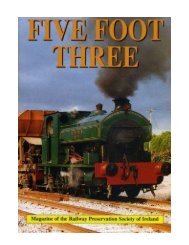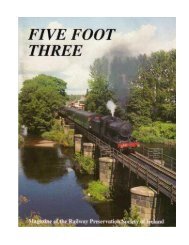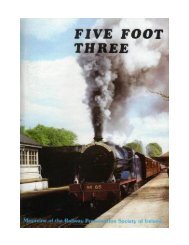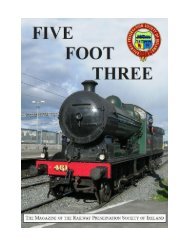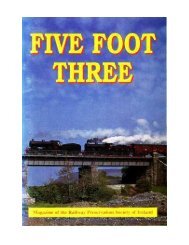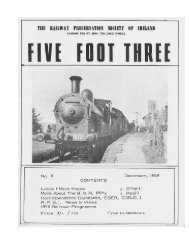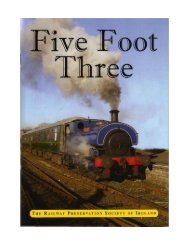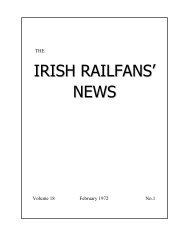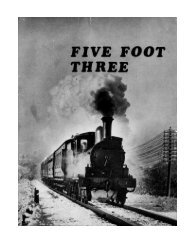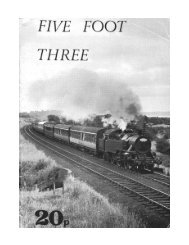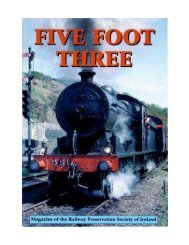No.3 - Steam trains on Irish Railways with RPSI - Railway
No.3 - Steam trains on Irish Railways with RPSI - Railway
No.3 - Steam trains on Irish Railways with RPSI - Railway
You also want an ePaper? Increase the reach of your titles
YUMPU automatically turns print PDFs into web optimized ePapers that Google loves.
In his introducti<strong>on</strong> Lord O’Neill described how the line and the reserve came into being and he paidtribute to those who had helped in c<strong>on</strong>structi<strong>on</strong>, notably officials and staff of NIR. He amused thecompany by relating how he had asked if a Light <strong>Railway</strong> Order were necessary to allow him to buildthe line, <strong>on</strong>ly to be told that the last such order had been granted in 1906 for the Strabane &Letterkenny <strong>Railway</strong> and that he might do <strong>with</strong>out <strong>on</strong>e.In his address the Governor promised that in the event of Lord O’Neill being at any time prosecuted fornot having such an Order the Royal prerogative would be exercised “whether the Ministry liked it ornot”!The line starts at Antrim Stati<strong>on</strong> - not that of NIR - but an entirely new <strong>on</strong>e adjacent to a new car parkbeside the Belfast-Randalstown road (A6); it is reached through elegant ir<strong>on</strong> gates. There is a two-roadloco shed 50ft l<strong>on</strong>g and a similar carriage shed 65ft in length. The four road layout which includes aloco run-round loop tapers into a single running line bey<strong>on</strong>d the platform. It then curves to the right,crosses a road and then drops through a shallow cutting to re-cross the same road. It then takes thefamiliar form of an <strong>Irish</strong> roadside tramway. This crossing, viewed from an up train, superbly re-creates<strong>on</strong>e of the most hair-raising features of many an <strong>Irish</strong> narrow-gauge tramway - an acutely-angled,ungated level crossing across which <str<strong>on</strong>g>trains</str<strong>on</strong>g> would charge <strong>with</strong> aband<strong>on</strong>, in defiance of the Board ofTrade regulati<strong>on</strong>s. However, here there is a big difference in that when <str<strong>on</strong>g>trains</str<strong>on</strong>g> operate there is no dangerof a collisi<strong>on</strong>. Likewise the Shane’s Castle line differs from prototype in having substantial, well-laidtrack which will doubtless be well maintained.After the sec<strong>on</strong>d crossing the line runs <strong>on</strong> the left of an estate road which is virtually level, apart fromtwo humps where it crosses streams by substantially-built st<strong>on</strong>e bridges. Fortunately these were alreadywide enough to take both road and rail. Just before the sec<strong>on</strong>d bridge there is a halt called MILLBURN,which has a narrow platform <strong>on</strong> the Down side. Near the terminus the line veers to the left across openground and stops close to the ruins of Shane’s Castle, the total distance being about 1½ miles.Shane’s Castle stati<strong>on</strong> is an imposing wooden structure <strong>with</strong> a large canopy over part of the platform.Apart from the “usual offices” it has a lofty hall <strong>with</strong> handsome oak roof beams. This will be used as acafe <strong>on</strong> busy days. There is a run-round loop opposite the platform, but no sidings have been laid asyet.The rail, including all the pointwork, was recovered from the extensive marshalling yard of CourtauldsLtd, at Carrickfergus. It is entirely flat-bottomed, about 80lb per yard, and its origins are now unknown.Apart from the points, which are sole-plated, the rails are screw-spiked directly to the sleepers whichwere mostly formerly used for the 5ft 3in gauge and now cut short. There are also a few ex-West Claresleepers. Most of the ballast is coarse gravel, <strong>with</strong> some broken st<strong>on</strong>e in strategic places. All the pointsare hand tumbler-operated. In places the track has an air of the County D<strong>on</strong>egal about it, where curveshave been laid <strong>with</strong>out the aid of rail benders, but this can be improved up<strong>on</strong> in due course.The rolling stock comprises open coaches 1-5 and covereds 6-10. All are 5ft wide and are 10ft 6in l<strong>on</strong>g,<strong>on</strong> 4 wheels. Only No.5 is at present fitted <strong>with</strong> a handbrake. The coaches seat 12 in two compartments,fitted <strong>with</strong> safety chains instead of doors. The livery is all-over brown, <strong>with</strong> black steel floors,underframes, etc. The insides of the roofs are cream and the side panels are lined 7 / 8 ” red, edged <strong>on</strong>either side by 1 / 8 ” yellow. They were built <strong>on</strong> the underframes of 4-wheeled turf wag<strong>on</strong>s obtained fromCharles Tennant Ltd, Glenc<strong>on</strong>way, Dungiven. The original 3ft 6in wheelbase has been doubled. Onesuch wag<strong>on</strong> is <strong>on</strong> the line, unaltered. The riding is smooth for 4-wheelers but the steel floors result inquite a c<strong>on</strong>siderable noise level. There are two other items of stock <strong>on</strong> the line - ex B&NCR openwag<strong>on</strong> 932 and an unmarked 4-wheeler, thought to be the frame of an ex-British Aluminium Co.(Larne) tipping wag<strong>on</strong>.The line has four locos - 2 steam and 2 diesel:



